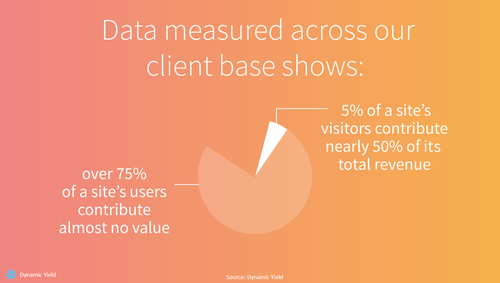By Liat Fuchs, Dynamic Yield

The age of market fragmentation and the increasing need for precision marketing are dramatically changing the way retailers are combining qualitative and quantitative methodologies.
By developing deep customer segmentations, retailers gain the power to both understand customer motivations and leverage digital marketing technologies to effectively connect with consumers. By profiling and segmenting customers and prospects, marketers can deliver unprecedented one-to-one tailored content to increase engagement and ultimately improve conversions.
Effective audience segmentation has evolved dramatically beyond demographics. Due to rapid adoption of sophisticated Software-as-a-Service (SaaS)-based personalization solutions, advanced segmentations aggregate a wealth of data, including interests and user preferences, behavioral and past interactions. Driven by data, the time needed to engage and move consumers to act has shrunk incredibly.
The More Data You Can Access, The Better Context You Have To Produce Insights
One of the biggest challenges of personalization is having enough data to gain valuable insight. Connecting the dots between data and insights often makes the difference between success and failure. Data sources include both third-party channels such as social signals, online surveys, call centers and even weather data, as well as on-site user behavior.
Effective data analysis offers countless opportunities to achieve rapid growth and create a data-driven marketing machine. In fact, data-driven marketing spending is constantly on the rise: More than 40% of U.S. marketing professionals said they increased spending on data-driven marketing during 2014, according to a research study published by Direct Marketing Association and the Winterberry Group.

Personalization Technology Connects The Dots
While fleshing out your initial customer personas still begins with the creative process, you can use quantitative segmentation to confirm and enrich your assumptions. While that process may take weeks, personalization technology can offer actionable insights in real time.
For example, data measured across our client base shows that only 5% of a retail site’s visitors contribute nearly 50% of its total revenue, while over 75% contribute almost no value. Analyzing the persona characteristics and attributes of the top converting segment can be complicated and time-consuming, but it’s a crucial prerequisite to implementing personalization. A sophisticated personalization engine could help identify and target these audience segments. For example, if your customers consistently convert late in the evening after viewing an offer during the day, you can use that information to target returning users with more compelling offers during those high-converting time slots.
Taking the above example of a returning visitor conversion even further, it would make sense to try to understand why this particular segment converts better. Perhaps the time of day enables the customer to share an offer with a family member or friend. If your data consistently shows that a conversion follows a social signal, you can update the offer to reflect consumer mindset and strengthen your connection to the buyer.
The Missing Link
Personalization technology is “the missing link” that connects audience segmentation to buyer personas. Think of your personalization engine as the machine that processes raw data to define and optimize customer segmentation.
At a higher level, customer segmentation directly impacts the creative process of constructing buyer personas, producing insights you can test and optimize in real time. As retailers learn to adopt personalization technology into the workflow, consumers will benefit from a more relevant experience, which will of course drive conversions and revenue.
Liat Fuchs is the VP Marketing at Dynamic Yield, a leading SaaS-based solution for real-time personalization and automated conversion optimization. Fuchs brings more than 10 years of experience in the International Online Marketing and Advertising arena, with vast experience on all fronts, including brand and product marketing, media buy, affiliate and publishers, SEO, SEM, social media, PR and more.






